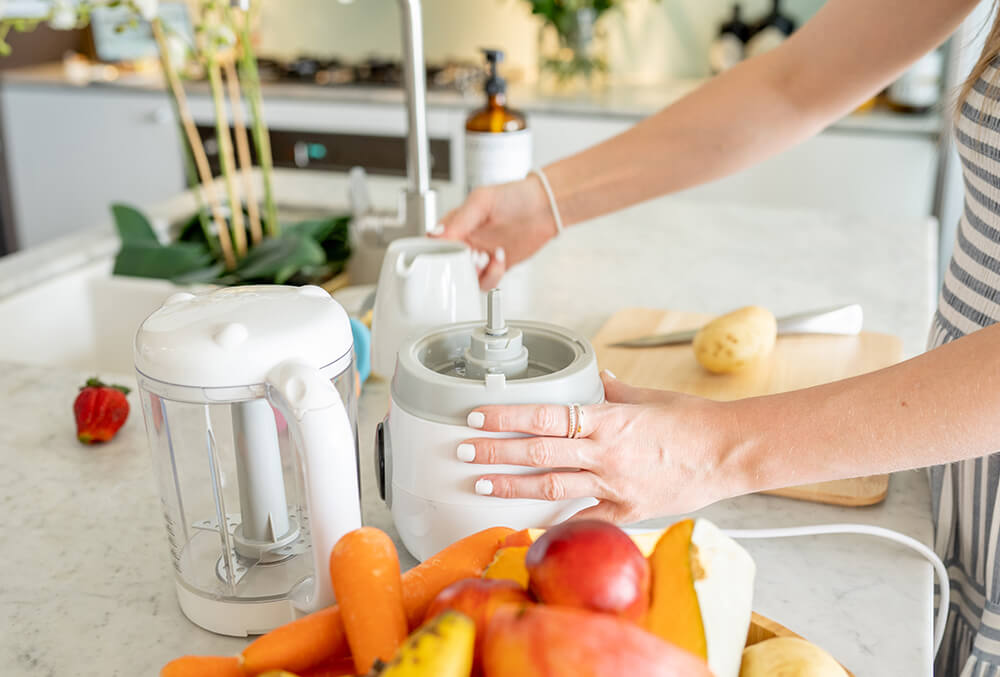Using Your Automatic Baby Food Maker

On this Page:
- Why Use An Automatic Baby Food Maker?
- Why Make Homemade Baby Food?
- Technical Precautions
- Preparing Your Baby Food
- When To Introduce Solids To Baby
- The Second Stage
- The Third Or Final Stage
Why Use An Automatic Baby Food Maker?
Making the best baby food for your little toddler has been made even easier with the use of an automatic baby food maker. Our Cherub Baby Automatic Baby Food Maker is a combined baby food maker that steams and blends homemade baby food. So all the essential processes are now integrated to help parents prepare the yummiest baby foods quickly and easily.

And to make it even more convenient for mums and dads, we’ve included an exclusive baby food recipe book with the unit. Now all you have to do is to figure out how to use your baby food maker. Cherub Baby is more than happy to show you how!
Why Make Homemade Baby Food?
So why would you want to use your own baby food steamer and blender? Aside from making it easier, most parents also find that using an automatic baby food maker is a safe way to make baby food. This is because you get to monitor the process yourself and know what is going into the food you make your child. As opposed to commercial baby products where you can never be too sure. Doing it yourself, using our Cherub Baby will ensure that your baby’s meal is touched only by your own hands.
You want to get the most out of this unit. To help you with this, Cherub Baby has compiled some important tips on how to use your food preparation unit.
Technical Precautions
Firstly, be sure to familiarise yourself with the technical basics of the food steamer and blender. The Cherub Baby Automatic Baby Food Maker comes with an instruction manual that has the step by step ways to use and maintain the device. Be sure to take a moment to read through the instruction manual that comes with your device.
Preparing Your Baby Food
Once you have taken note of the technical specifications of using your steamer-blender, you are ready to start. To begin with you will need to prepare the fruits or vegetables you will be using. This is the hardest part as you will need to peel and chop your veggies. Once done, the steamer blender takes care of the rest!
One good reason why integrated products like a baby food steamer blender are so convenient is because making your own baby food entails steaming/cooking the veggies first, before you blend them. This leads to more pots, pans and washing up. As the two processes (steaming and blending) are complimentary, an all-in-one steamer and blender unit is ideal.
When To Introduce Solids To Baby
One of the best ways of approaching the process of introducing solids to your baby is to pay attention. Your baby’s level of development and interaction or interest when you are eating is a good sign. Generally, parents are advised to introduce solid food to their baby at around six months. Depending on medical advice it may be done from 4 months onwards. Solids should only be slowly introduced after breastfeeding or formula feeding.
You may want to read more about signs to look out for here.
This is the first stage of solid feeding development. During this time, it’s advisable to start with very smooth basic foods like baby rice cereal, soft pureed potatoes or pumpkin. It might be tempting to make a flavoursome pureed gourmet dish for your baby, but don’t. At this early stage of their development, it’s more important that they get used to the essential skills, such as chewing, and not get overwhelmed by more complex flavours. This is why avoiding stronger ingredients like garlic, onions, salt and sugar is recommended.

The Second Stage
The second stage of your child’s solid feeding development comes after their first six to eight months (or as recommended by your doctor). Now they should be ready to experiment with tasty and combined foods. For this stage of development, you can try making more complex meals in your automatic steamer blender as included in the bonus cookbook.
A staple favourite is the beef, broccoli and sweet potato recipe. It’s savoury and easy to make for older babies who have now moved onto meat. The general process involves steaming the ingredients until they’re very tender. Then you can blend the ingredients to a thick consistency, leaving a bit of texture. At this stage of feeding development you can start to add some soft chunks and texture to the food. This will help you ‘train’ your baby to chew and eat solid foods.
The Third Or Final Stage
The last stage sets in about shortly after your baby reaches 9-10 months. Now you can make baby food that is actually real food in the sense that more mature children (or even adults) can eat them too. For this stage of development you can now experiment with dishes like burgers or rice meals cut into very small pieces for them to chew with close observation. This stage is individual to each baby and whether you baby has grasped the art of chewing.
What we’ve given there are baseline considerations when using your automatic baby food maker to introduce solid foods to your baby. These concepts will lay the foundation for effectively making your own healthy homemade baby food, and encourage your baby’s solid food development process.
EXPLORE OUR SOLID FEEDING RANGE!
References:
Introducing solids: why, when, what and how – Raisingchildren.net
Confused about introducing solids? – Australian Breastfeeding Association
Your baby’s first solid foods – NHS UK



